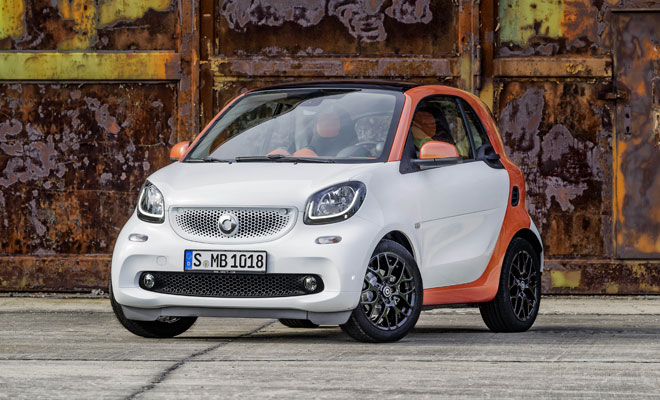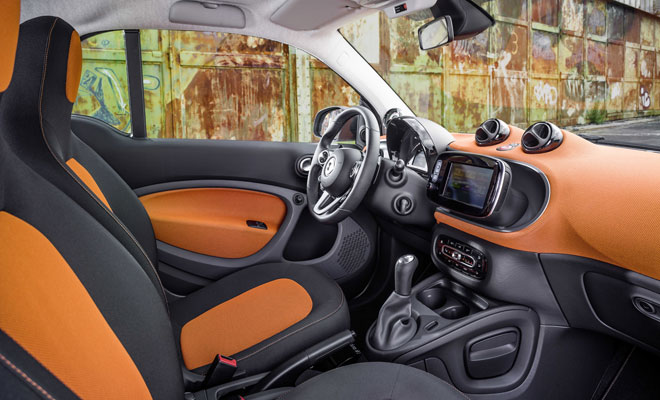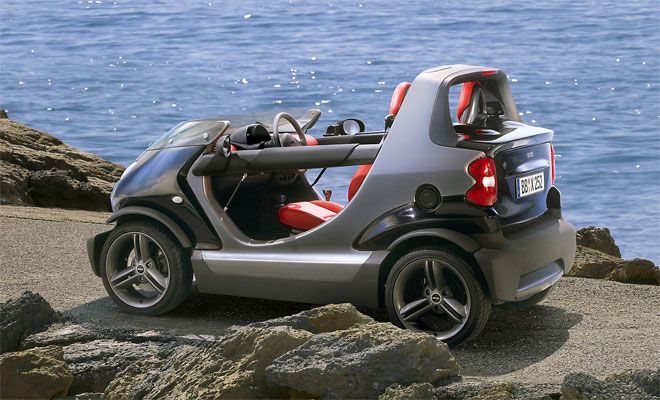by Lem Bingley
After a seemingly endless series of motor show concept cars, hinting at future directions, city car brand Smart finally revealed its next generation earlier this month. The third incarnation of the Smart ForTwo and the second ForFour provide a pair of compact cars designed for urban use. Both are due to arrive in dealers towards the end of the year.
The two-seater car features an actual bonnet this time around, with a modestly jutting front end providing better pedestrian protection than the egg-shaped existing Smart, apparently. Despite the reshaped profile, the new ForTwo remains extremely compact – at 2.69 metres it’s exactly the same length as the current Smart, sitting on roughly the same wheelbase. It’s about 10cm wider than before, however. Measuring about the same distance across the beam as a Fiat 500, the new ForTwo should provide noticeably better room to swing an elbow while remaining nippy enough to flit through gaps in city traffic.

Structurally, the new car retains the layout of its two predecessors, with a rear engine, contrasting steel safety cage and plastic body panels.
The ForFour, meanwhile, is a very different proposition to its predecessor. The first version of the ForFour, produced for only a brief period between 2004 and 2006, was essentially a redesigned Mitsubishi Colt – a conventional, front-wheel-drive, steel bodied, five-door hatchback, with Smart design cues slathered on top. The new one, by contrast, is essentially a ForTwo stretched out to accommodate an extra row of seats. And this time the sister car, the upcoming Renault Twingo, is essentially a Smart car with the distinctive design cues scraped off. You can tell which brand had the greatest sway by the rear positioned engine in both ForFour and Twingo.

The ForFour is a little more than a long-wheelbase ForTwo, of course. The nose of the car is also lengthened, providing a bigger crumple zone for a bigger car. Doors are skinned in steel rather than plastic. And there’s a one-piece hatch at the rear, whereas the ForTwo retains its familiar split tailgate, with fold-down and lift-up sections.
At 3.49 metres in length, the ForFour is shorter than a VW Up, Seat Mii or Skoda Citigo, but a couple of centimetres longer than the new Citroen C1, Toyota Aygo and Peugeot 108. With no engine under the nose there ought to be more cabin space in the ForFour than in the C1 family. The rear engine does mean luggage capacity will be in short supply, though not by as much as you might image. Boot volume is 185 litres versus the new C1’s 196 litres and the Up’s 251 litres. And given the proximity of the hot engine, it might not be advisable to carry home any tubs of ice cream in the boot.

Two new three-cylinder petrol engines will be offered when the new Smarts arrive. A 1.0-litre unit will provide 70bhp an 91Nm of torque, while a 0.9-litre turbocharged unit will offer 90bhp and 135Nm, with a fuel-saving stop-start system. An entry level 60bhp option will arrive a few months later. Fuel economy and CO2 figures remain to be confirmed.
Transmissions are also new, hopefully defusing the biggest bugbear with the outgoing Smart, which featured a frustrating semi-auto box that might seem snappy if you’re a tree-hanging sloth. The new cars feature a choice of conventional five-speed manual or six-speed dual-clutch automatic transmissions.

With the current Smart due to retire before the end of the year, now seems a good time to look back over past high and lows.

The first Smart ForTwo wasn’t called ForTwo at all, but City Coupé. Produced from 1998, the earliest models to arrive in the UK were imported left-hand-drive examples. Official imports with the wheel on the correct side of the car began only in late 2001.
Power: 599cc three-cylinder turbocharged petrol engines offering 44, 54 or 61 horsepower
Acceleration: From rest to 62mph took 18.9, 17.2 or 16.8 seconds, according to the chosen engine
Economy ratings: 57.6mpg combined, 118g/km of CO2
Current value: we found a tidy 2002 City Coupé with 60,000 miles via AA Cars for £1,990

Developed in tandem with the contemporary Mitsubishi Colt, the first four-seater Smart car didn’t hang around, being produced for only a couple of years between 2004 and 2006. The car was axed apparently due to slow sales, at a time when Smart was struggling to turn in the profits that would justify the brand’s existence. Somewhat misnamed – it’s actually a five seater – the ForFour was made available with a much wider selection of powertrains than its smaller relation.
Power: a choice of petrol and diesel engines producing from 64 to 174 horsepower.
Acceleration: from 13.5 to 6.7 seconds, according to engine output
Economy ratings: from 41 to 64mpg and from 116 to 159g/km
Current values: 2006 cars cost in the vicinity of £1,500 to £3,500 – we found a 50mpg, 1.1-litre car in plush Passion trim with 60,000 miles privately advertised for £2,100.

In 2002 Smart decided it would be a good idea to lop off the City Coupé’s roof, windscreen, doors and sundry other bits of bodywork to create the Crossblade, a flies-in-the-teeth edition of its two-seater. Left-hand-drive only, and without a useable roof, it was a brave choice in Britain. Despite a beefed up engine, the design’s challenging aerodynamics meant slower sprinting and an 84mph top speed.
Power: the same 599cc petrol engine as the City Coupé, tuned to produce 70bhp
Acceleration: 0-62mph in 17.0 seconds.
Economy ratings: 46mpg combined, 137g/km
Current value: rarity means silly money – we spotted one up for £16,500

Smart began dabbling with an electric ForTwo more than five years ago, progressing to limited trials with a version 2 car in 2010, before finally putting the third generation car on sale in early 2013. With its engine swapped for a motor and batteries, and direct drive in place of a balky gearbox, the Smart ForTwo ED is actually a lot of fun to drive.
Power: 55kW (74bhp) electric motor fed from a 17.6kWh lithium-ion battery
Acceleration: 0-62mph in 11.5 seconds
Economy ratings: zero emissions and 90-odd miles per charge
Current value: bought new, the ED costs from £15,395 including a discount via the Plug-in Grant; or £12,275 plus £55 per month battery rental. Used, we found a 2013 model with 2,600 miles, available for £10,989 through the Smart approved network.




